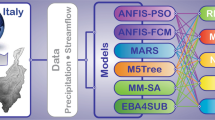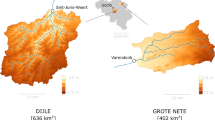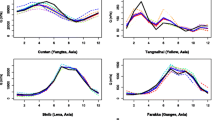Abstract
In this study, seven rainfall-runoff models were applied to model daily River Kafu flows from 1952 to 1981. Among others, models from the rainfall-runoff library of the eWater toolkit were applied. Optimal parameters of each model were obtained based on an automatic calibration strategy. Averaging in terms of simple arithmetic mean, hereinafter taken as the multi-model ensemble (MME), was performed to independently and identically distributed events separately extracted from the outputs of the individual models. How well the MME captured variation and frequency of observed hydrological extremes was assessed. Models performed better for high flows than low flows. Absolute model average biases on quantiles with return periods from 1 to 30 years were over the ranges 5.5–83.6% and 11.6–57.7% for high flows and low flows, respectively. It is envisaged that making model structures flexible and performing calibration with objective functions constrained to extreme events can enhance simultaneous capturing of high flows and low flows. The amount of variance in annual maxima series that could be explained by the multi-model ensemble was 73.4% and ranged from 35.1 to 82.5% for the individual models. This made the multi-model ensemble better than outputs from six of the seven models. For the annual minima flows, the multi-model ensemble yielded the smallest root mean squared error but the third largest coefficient of determination. Notably, the suitability of the multi-model ensemble in capturing the hydrological extremes depends on the selected goodness-of-fit measure, approach for combination of model outputs, number of models considered and length of data used.







Similar content being viewed by others
References
Abbott, M. B., Bathrust, J. C., Cunge, J. A., O’Connell, P. E., & Rasmussen, J. (1986a). An introduction to European hydrological system–Système Hydrologique Européen (SHE) Part 1. History and philosophy of physically based distributed modeling system. Journal of Hydrology, 87, 45–59.
Abbott, M. B., Bathrust, J. C., Cunge, J. A., O’Connell, P. E., & Rasmussen, J. (1986b). An introduction to European hydrological system: Système Hydrologique Européen (SHE) Part 2. Structure of a physically based distributed modeling system. Journal of Hydrology, 87, 61–77.
Amollo, C. J. (2020). Comparing the performance of different lumped conceptual hydrological models: a case study of River Kafu Catchment. MSc. Dissertation, Department of Civil and Building Engineering, Kyambogo University, Kampala, Uganda.
Ankit, B., & Tiwari, H. L. (2015). Rainfall runoff estimation using RRL toolkit. International Journal of Engineering Research and Technology, 4(5), 595–599.
Arnold, J. G., Srinivasan, R., Muttiah, R. S., & Williams, J. R. (1998). Large area hydrologicmodeling and assessment-Part I: model development. Journal of American Water Resources Association, 34(1), 73–89.
Arsenault, R., Gatien, P., Renaud, B., Brissette, F., & Martel, J.-L. (2015). A comparative analysis of 9 multi-model averaging approaches in hydrological continuous streamflow simulation. Journal of Hydrology, 529, 754–767.
Baker, L., & Ellison, D. (2008). The wisdom of crowds—ensembles and modules in environmental modeling. Geoderma, 147, 1–7.
Bergström, S. (1976). Development and application of a conceptual runoff model for Scandinavian catchments, SMHI RHO 7. Norrköping: SMHI.
Betrie, G. D., Mohamed, Y. A., Van Griensven, A., & Srinivasan, R. (2011). Sediment management modelling in the Blue Nile Basin using SWAT model. Hydrology and Earth System Sciences, 15(3), 807–818.
Beven, K., & Binley, A. M. (1992). The future role of distributed models: Model calibration and predictive uncertainty. Hydrological Processes, 6, 279–298.
Beven, K. J., Calver, A., & Morris, E. M. (1987). The Institute of hydrology distributed model. Wallingford: Institute of Hydrology. (Report 98).
Bitew, M. M., & Gebremichael, M. (2011). Are satellite-gauge rainfall products better than satellite-only products for Nile hydrology? In A. M. Melesse (Ed.), Nile River Basin (pp. 129–141). Amsterdam: Springer.
Boughton, W. (2004). The Australian water balance model. Environ Model Softw, 19(10), 943–956.
Burnash, R. J. C. (1995). The NWS River forecast system-catchment modeling. In V. P. Singh (Ed.), Computer Models of Watershed Hydrology (pp. 311–366). Colorado: Water Resources Publications.
Calver, A., & Wood, W. L. (1995). The institute of hydrology distributed model. In V. P. Singh (Ed.), Computer Models of Watershed Hydrology (pp. 595–626). Colorado: Water Resources Publications.
Croke, B. F. W., Andrews, F., Spate, J., & Cuddy, S. M. (2005). IHACRES User Guide, Technical Report 2005/19, iCAM. Canberra: The Australian National University.
DHI. (2007). Reference manual of MIKE11—a Modeling System for Rivers and Channels. Hørsholm: DHI Water & Environment.
Diks, C. G. H., & Vrugt, J. A. (2010). Comparison of point forecast accuracy of model averaging methods in hydrologic applications. Stochastic Environmental Research and Risk Assessment, 24, 809–820.
Duan, Q. (1994). The SCE-UA method. Journal of Hydrology, 158, 265–284.
Easton, Z. M., Fuka, D. R., White, E. D., Collick, A. S., Ashagre, B. B., McCartney, M., et al. (2010). A multi basin SWAT model analysis of runoff and sedimentation in the Blue Nile, Ethiopia. Hydrology and Earth System Sciences, 14(10), 1827–1841.
Ebrahim, G. D., Jonoski, G. Y., van Griensven, A., & Di Baldassarre, G. (2013). Downscaling technique uncertainty in assessing hydrological impact of climate change in the Upper Beles River Basin, Ethiopia. Hydrology Research, 44(2), 377–398.
Esmali, A., Golshan, M., & Kavian, A. (2020). Investigating the performance of SWAT and IHACRES in simulation streamflow under different climatic regions in Iran. Atmósfera. https://doi.org/10.20937/ATM.52740.
Grayson, R., Blöschl, G., Western, A. W., & McMahon, T. A. (2002). Advances in the use of observed spatial patterns of catchment hydrological response. Advances in Water Resources, 25(8), 1313–1334.
Haque, M., Rahman, A., Hagare, D., & Kibria, G. (2014). Parameter uncertainty of the AWBM model when applied to an ungauged catchment. Hydrological Processes, 29(6), 1493–1504.
Hargreaves, G. H., & Samani, Z. A. (1982). Estimation of potential evapotranspiration. Proceedings of the American Society of Civil Engineers, 108, 223–230.
Hargreaves, G. H., & Samani, Z. A. (1985). Reference crop evapotranspiration from temperature. Transactions of the American Society of Agricultural Engineers, 1, 96–99.
Jaiswal, R. K., Ali, S., & Bharti, B. (2020). Comparative evaluation of conceptual and physical rainfall–runoff models. Applied Water Science, 10(48), 1–24. https://doi.org/10.1007/s13201-019-1122-6.
Jakeman, A. J., & Hornberger, G. M. (1993). How much complexity is warranted in a rainfall-runoff model? Water Resources Research, 29(8), 2637–2649.
Jakeman, A. J., Littlewood, I. G., & Whitehead, P. G. (1990). Computation of the instantaneous unit hydrograph and identifiable component flows with application to two small upland catchments. Journal of Hydrology, 117, 275–300.
Jarvis, A., Reuter, H. I., Nelson, A., & Guevara, E. (2008). Hole-filled seamless SRTM data V4, International Centre for Tropical Agriculture (CIAT). https://srtm.csi.cgiar.org. Accessed 20 Dec 2019.
Kerkhoven, E., & Gan, T. Y. (2006). A modified ISBA surface scheme for modelling the hydrology of Athabasca River Basin with GCM-scale data. Advanced in Water Resources, 29, 808–826.
Kouwen, N. (1988). WATFLOOD. A micro-computer based flood forecasting system based on real-time weather radar. Canadian Water Resources Journal, 13, 62–77.
Kouwen, N. (2000). WATFLOOD/SPL9: Hydrological model and flood forecasting system. Waterloo: Department of Civil Engineering, University of Waterloo.
Kouwen, N., & Mousavi, S. F. (2002). WATFLOOD/SPL9 hydrological model & flood forecasting system. In: Singh, V. P. and Frevert, D.K., (Ed.), Mathematical models of large watershed hydrology, pp. 649–685.
Kumar, A., Singh, R., Jena, P. P., Chatterjee, C., & Mishra, A. (2015). Identification of the best multi-model combination for simulating river discharge. Journal of Hydrology, 525, 313–325.
Kunnath-Poovakka, A., & Eldho, T. I. (2019). A comparative study of conceptual rainfall-runoff models GR4J, AWBM and Sacramento at catchments in the upper Godavari river basin, India. Journal of Earth System Sciences, 128(33), 1–15. https://doi.org/10.1007/s12040-018-1055-8.
Legesse, D., Vallet-Coulomb, C., & Gasse, F. (2003). Hydrological response of a catchment to climate and land use changes in Tropical Africa: case study south central Ethiopia. Journal of Hydrology, 275(1–2), 67–85.
Legesse, D., Vallet-Coulomb, C., & Gasse, F. (2004). Analysis of the hydrological response of a tropical terminal lake, Lake Abiyata (main Ethiopian rift valley) to changes in climate and human activities. Hydrological Processes, 18(3), 487–504.
Nash, J. E., & Sutcliffe, J. V. (1970). River flow forecasting through conceptual models part I—A discussion of principles. Journal of Hydrology, 10(3), 282–290.
Nielsen, S. A., & Hansen, E. (1973). Numerical simulation of the rainfall-runoff process on a daily basis. Nordic Hydrology, 4(3), 171–190.
O’Connell, P. E., Nash, J. E., & Farrel, J. P. (1970). River flow forecasting through conceptual models. Part 2. The Brosna catchment at Ferbane. Journal of Hydrology, 10, 317–329.
Onyutha, C. (2016). Influence of hydrological model selection on simulation of moderate and extreme flow events: A case study of the Blue Nile basin. Advances in Meteorology, 2016, 7148326. https://doi.org/10.1155/2016/7148326.
Onyutha, C. (2017). On rigorous drought assessment using daily time scale: Non-stationary frequency analyses, revisited concepts, and a new method to yield non-parametric indices. Hydrology, 4(4), 48. https://doi.org/10.3390/hydrology4040048.
Onyutha, C. (2019). Hydrological model supported by a step-wise calibration against sub-flows and validation of extreme flow events. Water, 11(2), 244. https://doi.org/10.3390/w11020244.
Onyutha, C. (2020). Analyses of rainfall extremes in East Africa based on observations from rain gauges and climate change simulations by CORDEX RCMs. Climate Dynamics. https://doi.org/10.1007/s00382-020-05264-9.
Pirnia, P., Darabi, H., Choubin, B., Omidvar, E., Onyutha, C., & Haghighi, A. T. (2019). Contribution of climatic variability and human activities to stream flow changes in the Haraz River basin, northern Iran. Journal of Hydro-environment Research, 25, 12–24.
Podger, G. (2004). User Guide—Rainfall Runoff Library. Australia: Cooperative Research Centre for Catchment Hydrology.
Porter, J. W., & McMahon, T. A. (1972). A model for the simulation of streamflow data from climatic records. Journal of Hydrology, 13, 297–324.
Reuter, H. I., Nelson, A., & Jarvis, A. (2007). An evaluation of void filling interpolation methods for SRTM data. International Journal of Geographical Information Sciences, 21, 983–1008.
Rojas, R., Feyen, L., & Dassargues, A. (2008). Conceptual model uncertainty in groundwater modeling: combining generalized likelihood uncertainty estimation and Bayesian model averaging. Water Resources Research, 44, 1–16.
Rutkowska, A., Willems, P., Onyutha, C., & Mlocek, W. (2017). Temporal and spatial variability of extreme river flow quantiles in the Upper Vistula River basin Poland. Hydrological Processes, 31(7), 1510–1526.
Sheffield, J., Goteti, G., & Wood, E. F. (2006). Development of a 50-year high-resolution global dataset of meteorological forcings for land surface modeling. Journal of Climate, 19(13), 3088–3111.
Staudinger, M., Stahl, K., Seibert, J., Clark, M. P., & Tallaksen, L. M. (2011). Comparison of hydrological model structures based on recession and low flow simulations. Hydrology and Earth System Sciences, 15, 3447–3459.
Sugawara, M., & Fuyuki, F. A. (1956). Method of revision of River discharge by means of a Rainfall model. Saitama: The Geosphere Research Institute of Saitama University.
Therrien, R., McLaren, R. G., Sudicky, E. A., & Panday, S. M. (2005). HydroGeoSphere: A three-dimensional numerical model describing fully-integrated subsurface and surface flow and solute transport (p. 322). Waterloo: Groundwater Simulations Group, University of Waterloo.
Twedt, T. M., Schaake, J. C., & Peck, E. L. (1977). National weather service extended streamflow prediction. In: Proc. 45th Western Snow Conference, Albuquerque, New Mexico, pp. 52–57. https://westernsnowconference.org/sites/westernsnowconference.org/PDFs/1977Twedt.pdf. Accessed 19 Apr 2020.
Wang, J., Yang, H., Li, L., Gourley, J. J., Sadiq, I. K., Yilmaz, K. K., et al. (2011). The coupled routing and excess storage (CREST) distributed hydrological model. Hydrological Sciences Journal, 56(1), 84–98.
Yang, Q., Zhang, H., Wang, G., Luo, S., Chen, D., Peng, W., et al. (2019). Dynamic runoff simulation in a changing environment: A data stream approach. Environmental Modelling and Software, 112, 157–165.
Yu, B., & Zhu, Z. (2015). A comparative assessment of AWBM and SimHyd for forested watersheds. Hydrological Sciences Journal, 60(7–8), 1200–1212.
Zhang, Q., Liu, J., Singh, V. P., Gu, X., & Chen, X. (2016). Evaluation of impacts of climate change and human activities on streamflow in the Poyang Lake basin, China. Hydrological Processes, 30(14), 2562–2576.
Acknowledgements
The authors are grateful to the Cooperative Research Centre for Catchment Hydrology in Australia for granting access to download the Rainfall Runoff Library. Acknowledgment is given to the Princeton Global Forcing, and the Ministry of Water and Environment, Uganda for data used in this study. The authors acknowledge that this paper was partly based on a study by Amollo (2020) under the supervision of Charles Onyutha (Ph.D.) and Jacob Nyende (Ph.D.).
Funding
This research received no external funding.
Author information
Authors and Affiliations
Contributions
All authors were involved in the conception of the study. CO and CJA were further involved in data acquisition, modeling, analysis, interpretation, drafting manuscript and making necessary revisions. JN and AN reviewed and made comments on the draft manuscripts. All authors reviewed and approved the manuscript for submission.
Corresponding author
Ethics declarations
Conflict of interest
The authors declare no conflict of interest.
Ethical approval
This article does not contain any studies with human participants or animals performed by any of the authors.
Electronic supplementary material
Below is the link to the electronic supplementary material.
Rights and permissions
About this article
Cite this article
Onyutha, C., Amollo, C.J., Nyende, J. et al. Suitability of averaged outputs from multiple rainfall-runoff models for hydrological extremes: a case of River Kafu catchment in East Africa. Int J Energ Water Res 5, 43–56 (2021). https://doi.org/10.1007/s42108-020-00075-4
Received:
Accepted:
Published:
Issue Date:
DOI: https://doi.org/10.1007/s42108-020-00075-4




